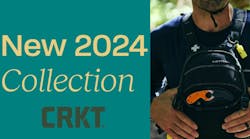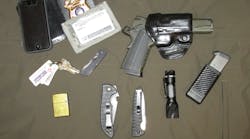I tested three knives for patrol use: An SOG Trident (TF-3), a Benchmade Paramilitary 2 (C81GPBK2) and a Benchmade 581S Barrage. Each knife was chosen for a different distinguishing characteristic. I theorized that the unique qualities of each knife would make each of them an excellent choice for hard law enforcement use. The test was an attempt to simulate about a year of patrol use. I began with 18 gauge copper wire and copper strand wire approximately the same thickness. I sliced through a ¾-inch manila rope, 1/8-inch at a time. Each knife got 100 cuts. I chopped several select natural pine boughs from various angles. I stuck the knives into tree trunks, edge down, then stood on the handles to test for lock failure. I figured if he knife could hold my (static) weight, they wouldn’t break under my use.
At the end of the test, I checked for sharpness and edge wear. What did I find? Exactly what I expected. I picked name brands because name brands are backed by reputation. What’s more reputable than SOG, Spyderco and Benchmade? Everyone knows if given the choice between a “tactical “ knife and a tool with a knife blade like a Leatherman Tool on patrol, I’d pick the Leatherman every time. However, when an officer needs a quick sturdy, one-handed blade, there isn’t a substitute. The three knives tested here are popular in law enforcement circles. They are traditional designs with a few engineering enhancements.
Benchmade 581S Barrage: knife sculpture for serious operators
The 581S Barrage was selected for this test because many officers want their knives to look like it belongs in a knife collection, and yet be cost effective enough to be a working knife. This is the knife. Even though this model is not “tactical black”, a close look will reveal that the blade has micro patterned lines almost perpendicular to the edge. It barely reflects light, giving it the look of a professional chef knife. Since I could slice a tomato hair thin with it, even after the edge wear test, the look is appropriate. This model comes with a black coated blade, but this is one good looking piece of steel.
The 581 Barrage uses the AXIS Assist locking mechanism, which is similar to the original AXIS Assist, except it has a spring assist. It features 3.60-inch M390 Super Steel drop point blade with a Rockwell hardness between 60-62. The most striking feature of this knife is the scales: G10 and aluminum with serrations that were eye-catching and useful. It also has a full length metal liner, recessed torx screw assembly and two positions for the pocket clip. The knife fills the gap between “I just purchased a custom knife” and “It’s a working blade designed to take a beating.” It is absolutely ideal for a law enforcement gift that will get the officer out of a challenging situation without equipment failure, and look good doing it.
I have an original Benchmade 710 in ATS 34 with the BT2 coating, an original AXIS Lock model, the non spring assist version. I got it when it first came out and have cut my way out of many situations while in uniform over 20 years.
The AXIS Assist locking mechanism uses the same principle. A deadbolt-like bar falls in behind the recess in the blade when opened. This does exactly what we desire in a folding knife: The inherent strength is indistinguishable from a fixed blade. The AXIS Assist locking mechanism adds a little extra to the mix. Because it is easy to polish the bearing surfaces of the lock, it is inherently the smoothest method to lock or unlock the knife. Users like myself have AXIS knives that have been opened and closed thousands of times in really bad environments without any noticeable wear.
Closing an AXIS knife is smooth and safe. One does not have to put the fingers in the path of the blade to use it. I am not a fan of automatic blades. It only takes firing one in the pocket to explain my feelings about them. The AXIS Assist mechanism is as fast as an auto, except stronger and safer. One simply starts the blade in motion, about 20-30 degrees, to open. It has a safety in the spine, allowing the user to open and close the knife with minimal grip shifting.
M390 is a tool steel often used in manufacturing. Its properties are suited for various aspects of the plastics manufacturing industry. Its formulation is good for repeated cutting tasks at lower temperatures. “Lower temperatures” means it is not a high speed cutting steel, which resists the high temperatures caused by friction. M390 also has a high chromium content which aids in its corrosion resistance.
M390 is made by sintering, which means that it begins as a powder which is heated at a controlled rate. This fuses the molecules and resists clumping of compounds, creating a more homogenous, fatigue resistant steel. M390 will accept a high polish and sharpens to a consistent and lasting edge. Bohler, the supplier of this steel, calls it M390 Microclean, based on its wear and corrosion resistance and likely its ability to accept a high polish. This polish, by the way, adds to the perceived sharpness of the Benchmade 581 Barrage. Benchmade calls M390 a Supersteel. And it really is.
The Benchmade 581 Barrage can do all of the cool tricks that a really sharp edge can do, like slice paper and shave the hair on one’s arm. More realistically, I found the hardness of the steel required a diamond stone to sharpen, unless I wished to sit there a while.
Besides getting “Oohs and Aaas” from other officers, the 581 Barrage performed exactly as advertised. Most testers use a guide, which consistently positions the blade when doing the manila rope test. This positions the cutting edge consistently, but this does not simulate “patrol like” conditions. I used a board and a kevlar patrol glove to hold the handle.
The 581 Barrage drop point blade is great for general duty, especially for varied applications. The tip can be inserted into some of the folds of a brick the officer found in the door panel or wheel well, or used to pry a sheetrock panel off a wall. I prefer a bigger recurve like the Bowie style in the SOG for cutting rope and wire, however. It puts more blade down on the problem.
I found the Benchmade 581 Barrage excelled in cutting rope because it filled the hand. The front serrations and the contours of the scales, combined with the extra thickness of the grip reduced the fatigue of this kind of cutting. Believe me, I had to take breaks every 15 minutes or so. I was thankful for the raw cutting power one can generate with this blade. Benchmade has signature edge serrations, which add to the excellent cutting ability, even when slicing wire.
SOG TF Series: great engineering wins every time
I tested the SOG TF-3, the lightweight, synthetic handled Bowie style knife with a synthetic handle and AUS-8 blade. This series of knife uses the S.A.T. (SOG Assisted Technology) opening, which, like the Benchmade, only requires the user to start the blade in motion. The Arc-Actuator locking mechanism uses a latch type of block to fix the blade.
The TF-3 was chosen for its cost effectiveness. SOG makes plenty of heavier, fully steel lined bowie styled knives, but the TF-3 relies on advanced engineering to keep the cost of this knife down. This knife can cost about a third of the price of many knives on patrol right now. Our tests proved that one can get a pretty good tool for the money. These knives were lighter than the others, mainly because the frame uses a metal liner which is more like a chassis than a full liner. The aggressively textured grip is molded around this frame.
The heart of the SOG TF-3 is AUS-8 steel, an affordable steel with edge holding characteristics, according to SOG’s Director of Marketing Chris Cashbaugh. The model is a continuation of the model line introduced about 7 years ago, part of the second generation of assisted opening knives. Cashbaugh told me that the model line centers around a Bowie-style blade and AUS-8 is used extensively in their products. The Cryogenic heat treatment, a method of heating the steel, then deep freezing it, aligns the steel, increasing the edge holding characteristic. Cashbaugh told me the likely candidate for this particular knife is a tactical user, either law enforcement or military or other classes of trade which require tools that will be subject to abuse. The most likely SOG TF-3 user will subject the knife to frequent situations under high pressure.
SOG is generally known for making high-performance products based on better engineering and moderately priced materials. The locking mechanism of the TF-3 is an example of better engineering. My tests with this particular locking mechanism confirmed the high performance aspect. It operated smoothly, even in a downpour, and after being subjected to fairly harsh cleaning chemicals. The SOG is for the intelligent user. The blade takes an edge readily, which is what well treated AUS-8 is known for. Unlike some steels, this knife can be honed to an ultra fine edge. However, repeated cutting of the manilla rope and cutting timber wore it down, after a LOT more cutting than expected for this test. The blade took a razor sharp edge with a diamond hone.
Bear in mind that proper heat treatment and steel temper are two different things. A blade can be tempered to a very high hardness and make a rather useless knife. For example, it could have a hard edge and be so brittle that a little flex will break the blade. AUS-8 requires the proper attention to make a cost effective steel into an excellent tactical blade. It is a common tool steel. SOG happens to give it optimum treatment, which really makes a difference in its ability to sharpen well.
AUS-8 is gaining a reputation for EDK knives. For those who don’t speak Knife, that means every day carry. CRKT is another company that has elevated AUS-8 (and its cousin 8Cr14MoV) steel. I have tested several M21 Series knives before and they outperformed all expectations, especially considering the cost. Our tests of the TF-3, found that the blade popped out smoothly, but the safety was hard to find and manipulate. The Arc-Actuator locking mechanism is not ambidextrous but it operated smoothly and locked solidly.
We put the TF-3 on patrol and its weight and balance was perfect. SOG uses a unique pocket clip which allows the knife to ride deep in the pocket without compromising deployment, even with gloves. The SOG TF-3 will give the officer plenty of service for a small investment.
The Spyderco Paramilitary 2 ( C81GPBK2): The game changer
When I selected the Spyderco Paramilitary 2 ( C81GPBK2), it was because, like many officers whose career was in the 90’s, I had an Endura. Not the one in the current catalog, but the one with the moulded pocket clip. It still is clipped to the inside pocket of my wife’s purse. They were great knives when I started my LE career working in the jail. I got it when I was (ok, I admit it) a fire fighter.
The Spyderco Paramilitary 2 ( C81GPBK2) resembles early models, but this is an elegant, refined piece. In fact, it is a Ferrari among Chevys in the world of working knives. During our tests, the Spyderco Paramilitary 2 cut, hacked, deployed and balanced in a manner that completely outstripped its size and weight. It uses CPM-S30V steel, a micro grain structure steel known for toughness, or resistance to chipping and breaking. It has a high resistance to corrosion and excellent edge holding characteristics. The Paramilitary 2 blade has the Spyderco Trademark Round Hole, which makes it a quick opener and adds to hand protection.
Of all the things the Paramilitary 2 does, it reigns supreme in handling. It has linen textured G10 scales, which encompass the entire metal frame. The hand only touches G10, which has a cat’s tongue feel to it. Funny, the Paramilitary 2 has a unique feel when opening. The blade is suspended in a cut out frame, which is the easiest design to clean and maintain. There is a “detent” feel when one puts the blade in motion, a deliberate feature. The blade swings through its arc in concert with the thumb that moves it, silently. This is not an assisted opening knife, although one would swear it is.
The Paramilitary 2 has a locking mechanism that looks like a liner lock, except it actuates on the spine side of the knife, not where the blade closes. It seemed sturdier and smoother than similar designs. Anyone that picked it up couldn’t put it down, including me. It also has a unique feel in the hand, not just the balance, but the fact that if someone tossed you a closed one, it could be oriented in the hand immediately, even when wearing gloves.
This knife excelled in cutting tests. It didn’t slip in the palm, and the skateboard deck grip feel just about wore out my hands.
The canoe like pommel on aids in the variety of hand positions one may use here. The top and the bottom of the blade have jimping, which let the user work up close or with a full hammer grip. This lightweight knife could hack and slash like a larger fixed blade, yet it is lightweight enough for EDK. In fact, I ran a few miles and rode over a hundred miles with this one clipped into my shorts.
I already knew a bit about the three knives I tested. I had a pretty good idea how they would do in the tests. One could not go wrong with any of them on patrol.



